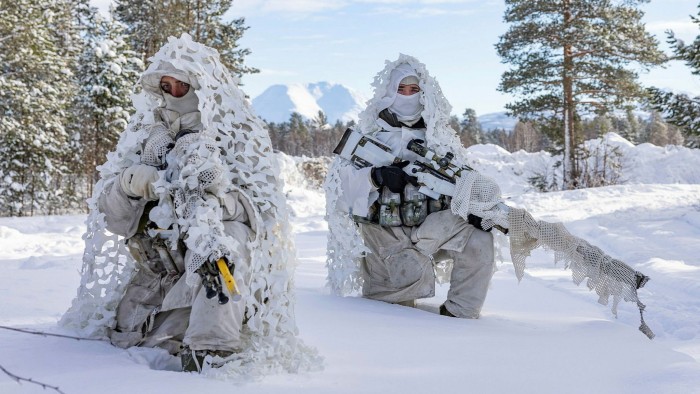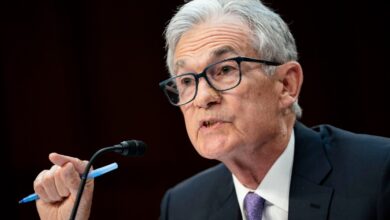UK must expand its Arctic military position, defence review to say

The UK must expand its military footprint in the Arctic and High North as the region becomes increasingly contested owing to melting sea ice opening up access, the government’s defence review is set to advise.
The document is expected to call for significant investment in drones and cutting-edge technology, against a backdrop of a new era of state conflict, according to people familiar with it.
The review will affirm the UK’s “Nato first” approach to defence, prioritising the security of Britain’s own backyard in the Euro-Atlantic area and fulfilling obligations to the alliance.
John Healey, defence secretary, has previously been scornful of the last Conservative administration’s “tilt” towards the Indo-Pacific in its defence and foreign policy.
The review is being led by an independent team headed by former Nato secretary-general Lord George Robertson, and was asked to examine the threats facing Britain, the capabilities needed to meet them, as well as the state of the armed forces.

The review has been heavily affected by US President Donald Trump’s shift in security policy, including his intention to scale down American military resources based in Europe.
There has been wrangling over the timing of the review’s publication, which the government promised in the first half of 2025. Described by defence officials as an “iterative process”, a fourth version was submitted to ministers on March 10, people familiar with the matter said.
Focusing on the Atlantic region, the review will recommend the UK steps up military activity in the High North, including the Arctic, the people said.
New shipping routes are opening up owing to ice melt, making the region’s rich natural resources, spanning oil, gas, minerals and rare earth metals, more accessible. This has stoked competition for influence and control among rivals, including the US, Russia, China and northern European nations.
The UK has already expressed concerns about Russia’s escalating militarisation of the region, and Healey travelled to Norway in February to discuss boosting its security.
Trump has, meanwhile, heaped pressure on Denmark to cede control of the Arctic island of Greenland to the US, sparking a diplomatic row.

The recent deployment of snowmobiles to the Arctic Circle by the MoD “indicated the direction of travel,” said one industry expert.
Ed Arnold, senior research fellow in European security at the Royal United Services Institute, said the UK is under pressure to provide more hard military capabilities to the High North from Nordic allies concerned about the US posture.
“They expect us to deploy a fuller military presence up there, because in terms of things like intelligence, surveillance and reconnaissance assets, and anti-submarine warfare, we are the only ones who can mitigate the US reallocating some of their resources to the Indo-Pacific,” Arnold said.
Deploying further assets and personnel to the High North would build significantly on the work of previous Conservative administrations. Former Tory defence secretary Ben Wallace set out a new Arctic strategy in 2022, which explained the threat without committing to new investment.
Industry executives said consensus was broad that the Royal Navy would secure more investment than the British Army because of the review. The message from eastern European Nato nations was that while they did not need land support, the capabilities of the RAF and the Navy were important, they said.

The review is expected to confirm the UK will press ahead with investment in the Global Combat Air Programme, an initiative between Britain, Italy and Japan, to create a sixth-generation stealth fighter jet.
While Sir Keir Starmer has vowed to increase defence expenditure from 2.3 per cent of GDP to 2.5 per cent from 2027, worth an additional £6bn a year, the pledge falls short of the 2.65 per cent sought by Britain’s military chiefs, meaning spending dilemmas lie ahead.
Investment in traditional platforms, including ships, jets and land vehicles, must be balanced with developing new, unmanned aerial and maritime systems and other novel technologies, the review is expected to say.
It is also set to prompt further work on boosting the cadet forces and reserves, and improve the Ministry of Defence’s links with fit and trained veterans in the event of a conflict, according to people familiar with it.
Ministers have set out plans for a “whole-of-society” approach, with some officials calling for more focus on democratic values, national resilience and defence in the school curriculum.
The review is also expected to examine the structuring of the UK’s cyber personnel, who straddle the signals intelligence agency GCHQ, the Ministry of Defence’s national cyber force, and other government units.

The idea is not to create a common command like “Space Force” in the US but to restructure and rationalise, so units are not trying to steal each other’s people and have a “common intake mechanism”, according to people familiar with the plan.
Some defence figures are pushing for the review to be released early next month ahead of the UK and EU attempting to secure a new defence pact at a summit on May 19, and in order to better influence a Nato meeting on June 24.
Other officials wish to publish later in June, to align with the Treasury’s spending review and a wider security strategy led by the national security adviser Jonathan Powell, the people said.
The MoD declined to comment on “speculation”, but added it is designed to “look hard at the threats we face and the capabilities we need to meet the challenges and opportunities of the 21st century” and will be published “as soon as possible”.
Additional reporting by Helen Warrell
https://www.ft.com/__origami/service/image/v2/images/raw/https%3A%2F%2Fd1e00ek4ebabms.cloudfront.net%2Fproduction%2F201b9459-cd54-4449-9bb2-e620488eb1d9.jpg?source=next-article&fit=scale-down&quality=highest&width=700&dpr=1
2025-04-18 20:00:56





